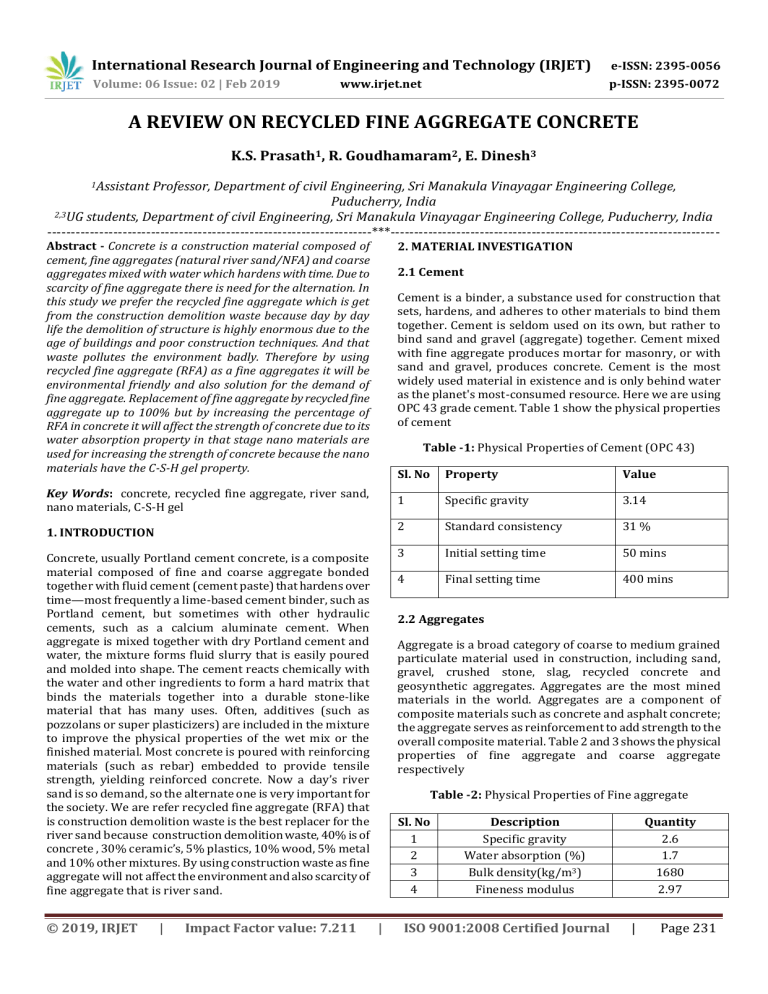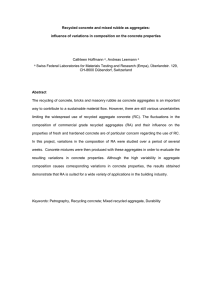IRJET-A Review on Recycled Fine Aggregate Concrete
advertisement

International Research Journal of Engineering and Technology (IRJET) e-ISSN: 2395-0056 Volume: 06 Issue: 02 | Feb 2019 p-ISSN: 2395-0072 www.irjet.net A REVIEW ON RECYCLED FINE AGGREGATE CONCRETE K.S. Prasath1, R. Goudhamaram2, E. Dinesh3 1Assistant Professor, Department of civil Engineering, Sri Manakula Vinayagar Engineering College, Puducherry, India 2,3UG students, Department of civil Engineering, Sri Manakula Vinayagar Engineering College, Puducherry, India ---------------------------------------------------------------------***---------------------------------------------------------------------- Abstract - Concrete is a construction material composed of cement, fine aggregates (natural river sand/NFA) and coarse aggregates mixed with water which hardens with time. Due to scarcity of fine aggregate there is need for the alternation. In this study we prefer the recycled fine aggregate which is get from the construction demolition waste because day by day life the demolition of structure is highly enormous due to the age of buildings and poor construction techniques. And that waste pollutes the environment badly. Therefore by using recycled fine aggregate (RFA) as a fine aggregates it will be environmental friendly and also solution for the demand of fine aggregate. Replacement of fine aggregate by recycled fine aggregate up to 100% but by increasing the percentage of RFA in concrete it will affect the strength of concrete due to its water absorption property in that stage nano materials are used for increasing the strength of concrete because the nano materials have the C-S-H gel property. 2. MATERIAL INVESTIGATION 2.1 Cement Cement is a binder, a substance used for construction that sets, hardens, and adheres to other materials to bind them together. Cement is seldom used on its own, but rather to bind sand and gravel (aggregate) together. Cement mixed with fine aggregate produces mortar for masonry, or with sand and gravel, produces concrete. Cement is the most widely used material in existence and is only behind water as the planet's most-consumed resource. Here we are using OPC 43 grade cement. Table 1 show the physical properties of cement Table -1: Physical Properties of Cement (OPC 43) Key Words: concrete, recycled fine aggregate, river sand, nano materials, C-S-H gel 1. INTRODUCTION Concrete, usually Portland cement concrete, is a composite material composed of fine and coarse aggregate bonded together with fluid cement (cement paste) that hardens over time—most frequently a lime-based cement binder, such as Portland cement, but sometimes with other hydraulic cements, such as a calcium aluminate cement. When aggregate is mixed together with dry Portland cement and water, the mixture forms fluid slurry that is easily poured and molded into shape. The cement reacts chemically with the water and other ingredients to form a hard matrix that binds the materials together into a durable stone-like material that has many uses. Often, additives (such as pozzolans or super plasticizers) are included in the mixture to improve the physical properties of the wet mix or the finished material. Most concrete is poured with reinforcing materials (such as rebar) embedded to provide tensile strength, yielding reinforced concrete. Now a day’s river sand is so demand, so the alternate one is very important for the society. We are refer recycled fine aggregate (RFA) that is construction demolition waste is the best replacer for the river sand because construction demolition waste, 40% is of concrete , 30% ceramic’s, 5% plastics, 10% wood, 5% metal and 10% other mixtures. By using construction waste as fine aggregate will not affect the environment and also scarcity of fine aggregate that is river sand. © 2019, IRJET | Impact Factor value: 7.211 Sl. No Property Value 1 Specific gravity 3.14 2 Standard consistency 31 % 3 Initial setting time 50 mins 4 Final setting time 400 mins 2.2 Aggregates Aggregate is a broad category of coarse to medium grained particulate material used in construction, including sand, gravel, crushed stone, slag, recycled concrete and geosynthetic aggregates. Aggregates are the most mined materials in the world. Aggregates are a component of composite materials such as concrete and asphalt concrete; the aggregate serves as reinforcement to add strength to the overall composite material. Table 2 and 3 shows the physical properties of fine aggregate and coarse aggregate respectively Table -2: Physical Properties of Fine aggregate Sl. No 1 2 3 4 | Description Specific gravity Water absorption (%) Bulk density(kg/m3) Fineness modulus ISO 9001:2008 Certified Journal Quantity 2.6 1.7 1680 2.97 | Page 231 International Research Journal of Engineering and Technology (IRJET) e-ISSN: 2395-0056 Volume: 06 Issue: 02 | Feb 2019 p-ISSN: 2395-0072 www.irjet.net Table -3: Physical Properties of Coarse aggregate Sl. No Description Quantity 1 Specific gravity 2.62 2 Water absorption (%) 1.21 3 Bulk density(kg/m3) 1560 3. COMPARISON 2.3 Recycled fine aggregate Crushed concrete aggregates also called as recycled concrete aggregates are fragments and pieces of concrete buildings which are demolished or rebuild. These crushed concrete are cleaned from dirt and broken to smaller pieces to manufacture aggregate which is termed as recycled aggregate. Table 4 shows the physical properties of recycled fine aggregate Chart -1: Comparison of physical properties of NFA & RFA By comparing the physical properties of natural fine aggregate and the recycled fine aggregate, specific gravity and bulk density of NFA are higher than the RFA. While the water absorption and the fineness modulus of RFA are higher than the NFA it denotes the RFA is a demolition waste one so that the water absorption and the fineness modulus are greater than the other. So finally the water cement ratio of natural fine aggregate concrete is very low ratio will use compared to the recycled fine aggregate concrete Table -4: Physical Properties of Recycled Fine aggregate Sl. No Description Quantity 1 Specific gravity 2.4 2 Water absorption (%) 2.04 3 Bulk density(kg/m3) 1360 4 Fineness modulus 3.35 4. CONCLUSIONS From this project we concluded, 2.4 Super plasticizer (SP) Super plasticizers, also known as high range water reducers, are chemical admixtures used where well-dispersed particle suspension is required. These polymers are used as dispersants to avoid particle segregation (gravel, coarse and fine sands), and to improve the flow characteristics (rheology) of suspensions such as in concrete applications. In this review we are prefer the supaflo as a SP. 2.5 Nano Materials Nanomaterials describe, in principle, materials of which a single unit is sized (in at least one dimension) between 1 to 1000 nanometers. Nano materials like nano silica, carbon nano tubes etc. having the capacity for formation of extra C-SH gel it will gain the strength of concrete while increasing the percentage of recycled fine aggregate | Impact Factor value: 7.211 Recycled fine aggregate is the best replacing material for the scarcity of natural fine aggregate/river sand Lower w/c ratio for Recycled fine aggregate concrete compared with natural fine aggregate concrete By using RFA it will be Environmental friendly because of using the construction demolition waste By increasing the replacement percentage of RFA it will lose the strength of concrete at certain point During that time nano materials helps to improve the strength of concrete because nano materials form the C-S-H gel while reacting with the cement and water. REFERENCES [1] © 2019, IRJET | Kou and Poon (2013) “Effects of Different Kinds of Recycled Fine Aggregate on Properties of Rendering Mortar”, Journal of sustainable cement based materials. ISO 9001:2008 Certified Journal | Page 232 International Research Journal of Engineering and Technology (IRJET) e-ISSN: 2395-0056 Volume: 06 Issue: 02 | Feb 2019 p-ISSN: 2395-0072 www.irjet.net [2] Serifou, Z.M. Sbartai, S. Yotte, M.O Boffoue, E. Emeruwa and F. Bos (2013) “A Study of Concrete Made With Fine And Coarse Aggregates Recycled From Fresh Concrete Waste”, Journal Of Construction Engineering. [3] Yehia, Helal, Abusharkh, Zaher, and Istaitiyeh (2015) “Strength and Durability Evaluation of Recycled Aggregate Concrete”, International Journal Of Concrete Structures and Materials. [4] Zega and Maio (2011) “Use of Recycled Fine Aggregate in Concretes with Durable Requirements”, Waste Management, 31, 2336-2340. [5] Zhu, Wang and Feng (2012) “Research on Properties Of Recycled Fine Aggregate From Waste Recycled Aggregates Concrete”, Advance Materials Research. © 2019, IRJET | Impact Factor value: 7.211 | ISO 9001:2008 Certified Journal | Page 233




